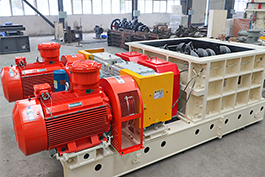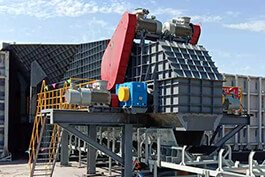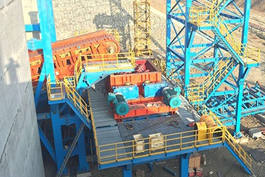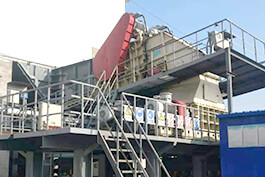Introduction
In the field of mineral processing, Mineral Sizer is one of the key equipment, and its stable and efficient operation is crucial for production. The motor and reducer, as the core power components of Mineral Sizer, can ensure precise power transmission of the equipment, make the mineral crushing particle size uniform, and also avoid excessive wear of components, reduce the occurrence of faults, and extend the service life of the equipment. If the motor and reducer do not operate synchronously, it will seriously affect production efficiency and benefits. Next, we will deeply explore the importance of synchronous operation and the implementation methods.
The Reason For The Synchronous Operation Of The Motor And The Reducer
Ensure the efficiency of material handling
Principle
In the Mineral Sizer, the motor provides the power, and the reducer regulates the rotational speed and torque of the motor output, operating synchronously to crush and screen the minerals at an appropriate speed and force, maintaining a stable working state, and processing the minerals at a uniform speed.
The negative impacts of in-sync operation
1. The motor rotates too fast while the reducer does not match in time
This leads to the crushing components of the Mineral Sizer operating beyond their normal working range. During the crushing process of minerals, they will be subjected to excessive impact and shear forces, resulting in a large amount of fine particles that do not meet the specification requirements, which will affect the quality of the final product.
2. The motor rotates slowly while the reducer's adjustment is lagging
This directly causes a significant drop in the processing speed of the Mineral Sizer. Specifically, the amount of minerals processed per unit time significantly decreases, failing to meet the expected processing standards, thereby seriously affecting the operation efficiency of the entire production line, making the overall production efficiency extremely low and unable to meet the production requirements.
.jpg)
Reduce failure risks
The benefits of synchronization
Broken parts and other components can operate according to the design requirements, ensuring that each component is subjected to uniform force during operation, maintaining the stability and extending the service life of the mineral sizer.
The negative impacts of asynchrony
1.Impact on gear components
When the motor starts to accelerate and the reducer fails to respond promptly, the gear components will be subjected to uneven force, resulting in accelerated wear and significantly affecting the normal working performance of the gears, as well as greatly shortening their service life and increasing the frequency of replacement and maintenance costs.
2. Impact on the entire equipment
If the motor and the reducer operate out of sync for a long time, the Mineral Sizer may experience an increase in vibration, and other components within the equipment will also suffer from wear and tear, thereby increasing the maintenance costs and downtime of the equipment.
Ensure safe production
The benefits of synchronization
When the components of the mineral sizer operate stably, it is possible to predict the operating status of the equipment more accurately, reducing the safety hazards caused by abnormal operation of the equipment.
The negative impact of asynchronization
1.Risk of equipment out-of-control
When the motor speed suddenly increases while the reducer fails to adjust in time, the motor and reducer are out of sync. The crushing components of the Mineral Sizer will generate a huge impact force due to the excessive rotational speed. This uncontrolled force may cause the equipment to deviate from the normal working trajectory, leading to equipment out-of-control and posing a serious threat to the personal safety of on-site operators.
2.Risk of secondary accident
Asynchronization operation may also cause damage to the internal structure of the equipment, such as loose connections and deformation of components. During the continuous operation of the equipment, these damages are highly likely to trigger secondary accidents, such as components falling out and injuring people, or the overall collapse of the equipment, bringing great safety risks to the production site and seriously affecting the normal operation of production and the safety of personnel.
3.Electrical safety hazard
Asynchronization operation may cause the electrical systems of the motor and reducer to bear additional loads. When the motor operates with unstable speed, it may experience excessive current and overheating, increasing the risks of electrical fires and equipment damage. At the same time, the instability of the electrical system may also affect the normal operation of other related equipment, further expanding the scope of safety hazards.
Low energy consumption during equipment operation
The benefits of synchronization
In a synchronized state, the power provided by the motor can be effectively regulated and distributed by the reducer, resulting in less energy consumption for the mineral sizer when completing the same material processing task.
The negative impact of asynchronization
1. Significant increase in energy consumption
When the motor and reducer are not synchronized, the motor needs to output additional energy to compensate for the deficiency in the reducer's regulation. For example, if the motor speed is too high and the reducer fails to match in time, the motor has to maintain high-speed operation continuously, which will cause a significant increase in the power consumption of the motor. Because in this case, the motor not only has to overcome the load during normal operation but also has to deal with the additional resistance caused by asynchronization, thus consuming more electrical energy.
2. Decrease in energy utilization efficiency
Asynchronous operation makes the power transmission process inefficient. The energy output by the motor cannot be reasonably converted into effective crushing and screening power through the reducer, and some of the energy will be wasted in the form of heat energy, vibrational energy, etc. For example, the vibration caused by asynchronization will consume some energy, and the abnormal friction of the internal components of the equipment will also consume energy, resulting in the inability to fully utilize the energy and increasing the production cost for Mineral Sizer when processing the same amount of minerals, requiring more energy consumption.
Methods To Achieve Synchronous Operation
Installation And Alignment
During the installation process, it is essential to ensure that the positions of the motor and the reducer are accurate. The connecting shafts of the motor and the reducer must be precisely aligned, with the deviation controlled within a very small range. The coupling is a key component that connects the motor and the reducer, and the selection of its type and the installation quality directly affect the synchronization effect. It is necessary to choose the appropriate coupling based on the specific working conditions of the Mineral Sizer.
For example, an elastic coupling can compensate for the misalignment of the shafts to a certain extent, but during installation, it is necessary to ensure that the elastic elements are installed correctly and the pre-tightening force is appropriate. After the installation is completed, carefully check the various parameters of the motor and the reducer, including speed, torque, power, etc., to ensure that they are in accordance with the design requirements of the equipment.
Maintenance and Inspection
Carry out regular maintenance on the lubrication systems of the motor and reducer. Follow the recommendations of the equipment manufacturer to replace the lubricating oil regularly and check the quality and cleanliness of the lubricating oil. At the same time, regularly inspect the mechanical components of the equipment.
Check the wear conditions of key components such as gears and bearings, and replace the severely worn parts in time. Inspect the connection parts of the mineral sizer to ensure the tightness of connecting components such as bolts and nuts, and prevent the equipment from experiencing increased vibration due to loosening, which may affect synchronous operation.
PLC Control System
The PLC analyzes and processes the feedback parameters based on the preset program and algorithm, and promptly adjusts the operating status of the motor and reducer. When it detects a deviation between the motor speed and the reducer speed, the PLC will quickly adjust the input voltage or frequency of the motor to make its speed match that of the reducer, achieving synchronous operation. At the same time, the control system can also implement remote monitoring and fault diagnosis functions. The operation data of the Mineral Sizer is transmitted to the remote monitoring center.
Once the equipment encounters abnormal conditions, the control system can promptly issue an alarm signal and analyze the fault cause through the fault diagnosis algorithm, providing accurate fault information to the maintenance personnel, enabling them to quickly carry out maintenance and handling, reducing equipment downtime and improving production efficiency.
Staff Training
The quality and skills of the staff operating the Mineral Sizer also have an important impact on the synchronous operation of the motor and gearbox. Enterprises should provide professional training for operators, so that they can understand the working principles and operating requirements of the equipment.
Operators should be able to correctly start and stop the equipment, and be able to detect and report abnormal situations in time. Through training, operators can better cooperate with maintenance personnel to ensure the long - term stable and synchronous operation of the equipment.
Conclusion
In the field of mineral processing, the synchronous operation of the Mineral Sizer's motor and gearbox is of great significance. It directly affects the efficiency of material processing, reduces the risk of equipment failure, ensures safe production, and reduces energy consumption. Understanding the reasons for synchronous operation and taking effective measures can enhance the performance and reliability of the mineral sizer, thereby improving production efficiency and economic benefits.


.jpg)


.jpg)







